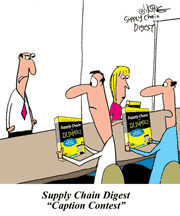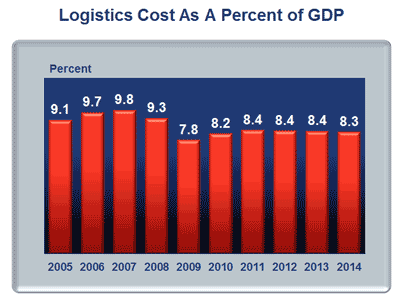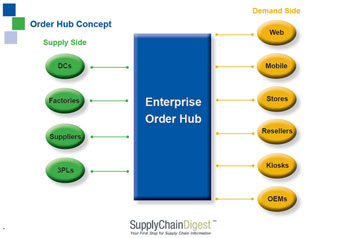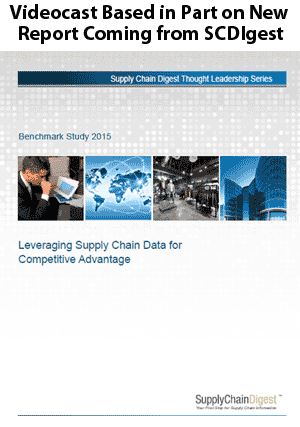 |
June 25, 2015 - Supply Chain Flagship Newsletter |
 |
| FEATURED SPONSOR: RESILINC |
||
 |
||
Download the Ultimate Guide to Supply Chain Resiliency Program Success! |
 |
|
||||||||||||||||||||||||||||||||||||||||||||||||||||||||||||||||||||||||||||||||||||||||||||||||
As usual, Wilson presented the study at the National Press Club in Washington DC on Tuesday, followed as it has been for the past few years by a panel discussion, this year moderated by Kevin Smith of Sustainable Supply Chain Consulting (and former head of supply chain for CVS stores) with participants from Penske Logistics, BNSF Railway, Boeing, Domino's, and Yusen Logistics. As a comparison, logistics costs as a percent of GDP were estimated at 15.8% in 1981 (as trucking deregulation was just starting and interest rates were high) and 12% in 1985. So as an industry we have made much progress. To make sense of all that, a graph of the last 10 years of logistics costs as a percent of GDP is provided below. This notion that relative logistics costs actually fell a tick in 2014 frankly surprises me, as truck rates by many measures were up strong year over year, as were warehouse rents, but diesel costs of course were down sharply in the last 4 months of the year, and rail pricing power dropped considerably,
|
|||||||||||||||||||||||||||||||||||||||||||||||||||||||||||||||||||||||||||||||||||||||||||||||||
Penske, meanwhile, more recently took on the lead corporate sponsor role. This year's report is also much more stylized than previous editions, with fancier graphics. Ok, before I highlight a few more of the top data from 2014, a small editorial comment. I continue to see observers in the supply chain trade press and elsewhere somehow miss the key point of changing logistics costs, reacting almost in disappointment when logistics costs don't keep up with GDP. Well, if you are a carrier or a 3PL maybe that makes sense. But if you are a shipper, or observer of the US economy, logistics costs falling as a percent of GDP is a sign of progress, all other things being equal. The US has had lower logistics costs relative to GDP than most other nations - a competitive advantage. We should celebrate lower logistics costs, whether they were achieved from falling oil prices, modest rate hikes, a bit of luck in market dynamics, or all of the above. With that off my chest, the total cost of US logistics was estimated at $1.449 trillion for 2014, up $43.4 billion from 2013. A lot of elements go into that number, from warehouses to trucking to pipelines, but the three main categories are inventory carrying costs, including the costs of warehousing (32.8% of the total logistics spend in 2014), transportation costs (62.6%), and administrative costs, mostly related to logistics IT spend not otherwise captured in the other two categories (just 4.6% of the total). You can see this breakdown here in our Supply Chain Graphic of the Week. Perhaps surprisingly, “local” trucking costs - presumably deliveries of goods like beer and furniture - represent about 31% of total trucking spend, versus 69% for “intercity.” The approximate $1.45 trillion in total logistics spend was 29.4% above the 2009 bottom, and was finally higher in absolute terms than the peak year of 2007, when spend was $1.42 trillion. That it took seven years to get back to the logistics spending level we saw in 2007 is really amazing, and shows just how deep the great recession really was. Greater logistics efficiency, such as the rise in intermodal volumes, reduction of empty miles, and other tactics, may play some role here, but I'll note US manufacturing output just got back to 2007 levels in July, 2014. Inventory carrying costs were up 2.1% in 2014, down from a rise of 2.8% in 2013. But most of that rise in carrying costs in absolute terms came from a similar rise in total inventory levels. The higher the absolute level of inventory, the higher the absolute spend for insurance, taxes, depreciation, etc. The interests costs of holding inventory were again almost negligible - just $2 billion, according to the report's methodology, which just applies the rates for “commercial paper” (short term corporate bonds) to average inventory levels. Those rates remain amazing low - just 0.09% or so for 2014, though that was up from 0.07% at the beginning of the year. We couldn't find it in this year's report, but in the 2014 Wilson noted that if the 2007 interest rate of 5.07% was in play, interest on carrying the inventory and thus total logistics costs in 2013 would have increase by $128 billion. That, in turn, would have changed logistics cost as a percent of GDP from 8.4% to over 9.0% - a sizable difference. Here are a few other highlights from the data: Overall transportation costs were up 3.6% in 2014, mostly "because of stronger shipment volumes," the report says. The data is conflicting, because the number of shipments is said to have decline a bit, while the ATA's tonnage index rose 3.5% for the year. The report notes correctly that trucking capacity was very tight for most of 2014, naturally pushing rates higher. There is lots more or course, but that's all I have room for. The report is available at no charge for CSCMP members, of which I am one. It can also be purchased by non-members. We will do a video summary in our news broadcast with CSCMP coming up on Monday. |
|||||||||||||||||||||||||||||||||||||||||||||||||||||||||||||||||||||||||||||||||||||||||||||||||
|
|||||||||||||||||||||||||||||||||||||||||||||||||||||||||||||||||||||||||||||||||||||||||||||||||
|
|||||||||||||||||||||||||||||||||||||||||||||||||||||||||||||||||||||||||||||||||||||||||||||||||
|
|
|
YOUR FEEDBACK
We received some modest Feedback on our article on Kroger being the latest retailer to begin a program to hire disabled workers in a distribution center, but wondering why more retailers haven't initiated these programs after success at Walgreens and a few others. Some of the Feedback from our partners over a RetailWire.
Feedback on Disabled Worker Programs in Retail DCs:
There are more risks in the distribution center than in the stores. The key is that Kroger has been so aggressive in getting disabled workers into the stores. I shop at Frys, a Kroger arm in Arizona, and have great relations with the many disabled employees at our favorite Frys store. It's great to see and they're dedicated workers who love what they do - and we all ignore their challenges. Tom Redd |
||
The article does a good job of summing up most of the reasons but avoids the one key reason: discrimination. People feel uncomfortable around people who have disabilities. As the article says, and research has shown, employees with disabilities if hired and trained properly can be real assets. Mel Kleiman Humetrics
|
||
At the risk of stating the obvious: because distribution center (warehouse) work is physically demanding, and often dangerous, and the list of disabilities which cannot be accommodated is long (visual impairment, paralysis, neuromuscular conditions, etc.). Walgreens and Kroger are to be applauded - even if the modest claim of serving their self-interest is true - but I'd be cautious about stereotyping (even a seemingly positive one). I suspect the (perceived) greater reliability is largely due to more rigorous screening. Anonymous |
||
I believe there is just a lot of mystery here to most distribution companies and retailers. You are afraid of what you don't know. In addition, I think these initiatives are perhaps obviously best suited for DCs with a lot of piece picking, which is true in many/most retail DCs, but perhaps why the move has not spread to other sectors. But in the end, these programs seem to be having success, so more companies should be looking at them. Christian Wolfe Long Island, NY
|
SUPPLY CHAIN TRIVIA ANSWER
Q: What country by far has the highest factory "robot density," measured as the number of industrial robots per 10,000 manufacturing workers?
A: South Korea, at 437, followed by Japan at 323 and Germany at 282, the US at 152 and China at just 30 - but rising fast.
| © SupplyChainDigest™ 2003-2015. All Rights Reserved. SupplyChainDigest PO Box 714 Springboro, Ohio 45066 |
POWERED BY: XDIMENSION
|









